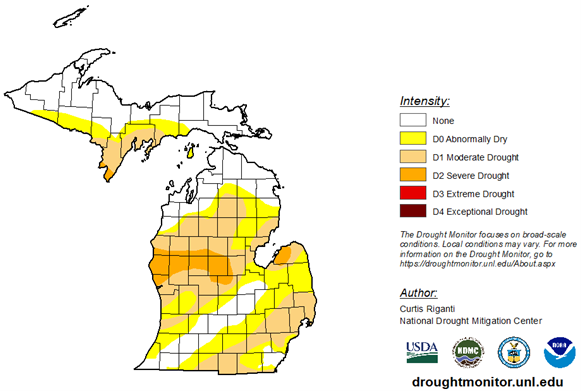By Anna Hooks and Jaime Luke
Persistent drought conditions within Michigan in 2025 have left livestock producers and their grazing lands at risk for forage loss. As shown in Figure 1, many Michigan counties are currently experiencing some level of drought conditions. The USDA Farm Service Agency (FSA) administers the Livestock Forage Disaster Program (commonly referred to as LFP). LFP provides compensation to eligible livestock producers who have dealt with loss of forage due to drought.

Which producers are eligible for LFP?
To be eligible for LFP, producers must own, cash or share lease, or be a contract grower of eligible livestock during the 60 calendar days before the beginning date of a qualifying drought. Eligible livestock are grazing animals that get the majority of their nutrition via grazing of forage grasses or legumes. These can include alpacas, beef cattle, buffalo/bison, beefalo, dairy cattle, deer, elk, emus, equine, goats, llamas, ostrich, reindeer or sheep. Producers must provide pasture or grazing land for covered livestock. This includes cash-rented land as of the date of the qualifying drought. Such land must be physically located in a county affected by a qualifying drought during the normal grazing period for the county.
What is considered a qualifying drought?
Qualifying droughts are determined by the U.S. Drought Monitor, using existing measures: D2 (severe drought), D3 (extreme drought), and D4 (exceptional drought). LFP compensation amounts are based on the severity and duration of drought conditions.
If any part of the county experiences severe drought conditions (D2) for at least eight consecutive weeks during the normal grazing period, producers are eligible for one monthly payment. If any area of a county reaches D3 at any period of time during the normal grazing period, producers are eligible for compensation equal to three monthly payments. Table 1 summarizes the remaining payment rates and drought qualifications.
Source : msu.edu